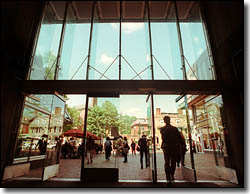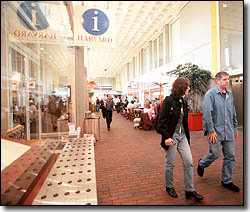Holyoke Center Arcade: from neglected ‘wind tunnel’ to bright, bustling walkway

When Josep Lluis Sert, the former Dean of the Graduate School of Design (GSD), sketched his architectural drawings for the “futuristic” Holyoke Center 40 years ago, odds are he gave no thought whatsoever to such 21st-century amenities as Internet workstations and automated teller machines. Even an espresso bar was probably out of the realm of possibilities.
How things have changed in the Holyoke Center arcade.
What was originally designed as nothing more than a windy thoroughfare linking Harvard Yard with the river houses has emerged as a bustling center of activity, shopping, food, and art. The transformation has taken time, money, and a great deal of strategic planning.
To fully appreciate the transformation, one must go back to the days when the arcade was an open-air passageway, devoid of any major retail use, and often filled with more transients than students. Nike Damaskos, the assistant director of leasing, who grew up in Cambridge, remembers the arcade as a dangerous and dank “wind tunnel” that repelled more visitors than it attracted.
“It was a dysfunctional space at the core of the campus,” says Scott Levitan, director of university and commercial real estate. “It was a very challenging design problem to bring [the arcade] up to a standard that would be useful.”
Blocking Out the Wind
In the late 1980s and early 1990s, according to Levitan, the University began investigating ways to better utilize the arcade space, “to build on the retail surge in Harvard Square.” The first major retail push came in the fall of 1993 when “The Shops by Harvard Yard” made their debut. New stores, restaurants, signage, and public restrooms were added, along with glass walls to help block the wind and moderate the temperatures inside.
Unfortunately, the Shops were not a success. Damaskos, who wasnt working for the University at the time, says the retail mix may have been too upscale for its location. “It was trying for something that you would see typically in Faneuil Hall or at South Street Seaport [in New York], a tourist-attraction-type retail market. Some of the comments at the time were What does this have to do with Harvard? and How does this enhance the retail environment that exists at Harvard Square?”
Those are the questions Levitan and others at Harvard Planning and Real Estate grappled with as they went back to the drawing board. “We hit on this idea of using the arcade as a programmatic front door for visitors to the University,” he says. That idea, balanced with the goal of serving the needs of both students and local residents, became the focal point for planning the next phase of development.

Preparing for Slam-Dunk Success
The latest reincarnation of the Holyoke Center arcade Harvard Information, Shops, and Services began with a lease agreement with Harvard Student Agencies, which located its Campus Store on Holyoke Street. Soon after, the Technology Products Center moved into a storefront on Dunster Street. Then, planners scored their biggest coup yet, landing Harvard Collections, a retail outlet for hundreds of specialty items marketed by 17 University museums and allied institutions.
“It was considered, at the time, the riskiest thing we were undertaking in the whole transformation in the arcade,” Damaskos says. “We are an institutional real estate group, and we dont do retail. We had never owned and operated a retail establishment, so we had to rely on other people to tell us what to do. We also had to convey to those people the abstractness of the vision of what this store had to become.
“The day before the store opened [in the fall of 1998], wed all been talking about how we were going to manage the bad press we were going to get on it, and the fact that it was going to fail, but then, as I looked around and saw what a great job [retail manager] Chausey Dickinson and her staff had done designing the store, I soon realized that we had it all backwards, that we should be preparing for slam-dunk success.”
Indeed, Harvard Collections soon became a favorite destination for shoppers at Harvard Square, paving the way for other arcade improvements, including the expansion of the Harvard Events & Information Center [complete with desktop computers with internet access], the creation of the Harvard Box Office, and the installation of an ATM machine by the Harvard University Employees Credit Union. In March of 1998, a new restaurant, Campo de Fiori, began operating its giant Italian ovens in the arcade.
A Nice Little Oasis
A stroll through the arcade these days is enhanced not only by the smell of fresh Italian bread, but also by a series of rotating art exhibitions in the south elevator lobby. “The basic concept of the exhibition space is to showcase work by the Harvard community,” according to Vanessa Trien, the Holyoke Center events and exhibitions coordinator. “Were trying to make it into a viable community arts resource.”
The colorful paintings certainly symbolize the dramatic changes that have taken place in the arcade over the past several years. “I happen to think it has become one of the nicest little oases at Harvard Square,” Damaskos says. “We have worked very hard to serve both our Harvard constituencies and our community constituencies and I believe weve reached a certain level of success.”
“It has met the vision of providing a locale for visitors and affiliates to find and secure Harvard services,” Levitan explains. “That is what we set out to do.”
So what would Josep Lluis Sert make of his Holyoke Center arcade today? Damaskos, for one, isnt quite sure, although she says she “cant imagine that he wouldn’t, as an architect, enjoy an enlivenment of his space. I cant help but think hed be somewhat pleased.”




